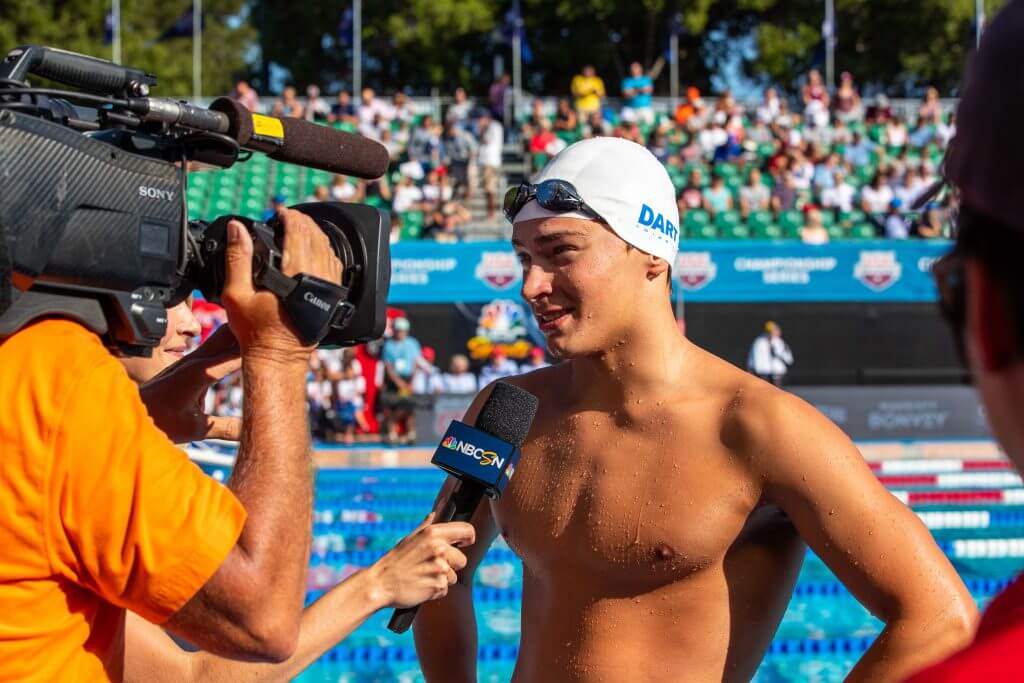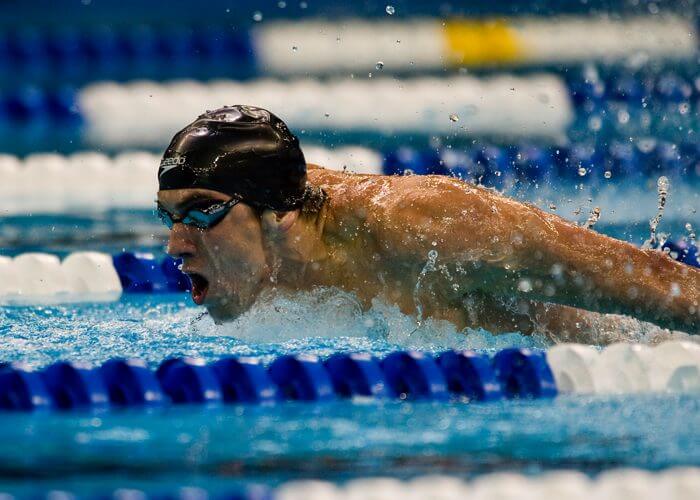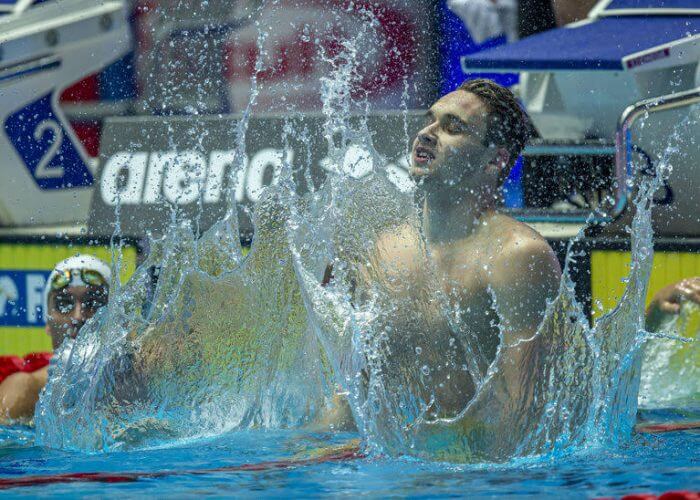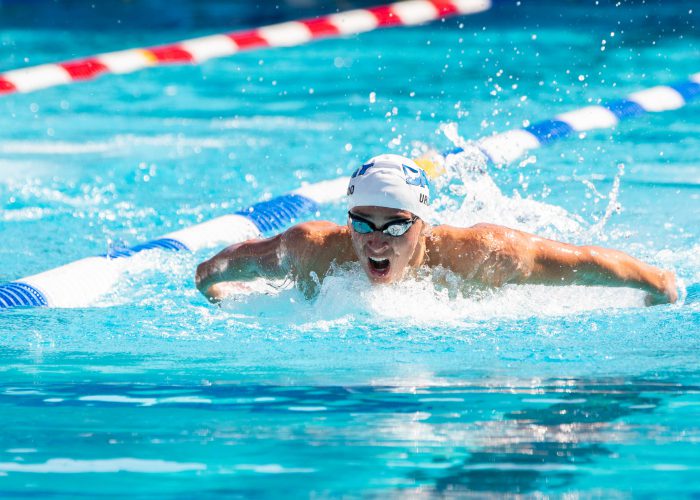Gianluca Urlando’s World Junior Titles A Dress Rehearsal For Bigger Waves

World Junior Championships (Gianluca Urlando Dress Rehearsal)
Budapest – August 21-26
Gianluca Urlando turned 17 in March this year, three months shy of a 1:53 effort over 200m butterfly. Long-course. One of the headliners for the USA team at World Junior Championships that get underway in Budapest tomorrow, he will not race the four-lap ‘fly until the last of the six days of competition, next Sunday, August 25.
Late August: a prestigious time of year in the history of 200 ‘fly swimmers. A Who’s Who of ‘Fly Firepower to have set the world record this time of year includes Carl Robie, John Ferris, Mark Spitz, Gary Hall (all USA), Hans Fassnacht (FRG), Craig Beardsley (USA), Michael “The Albatross Gross (FRG), Jon Sieben (AUS) and… Michael Phelps, the American who ended his career in 2016 with 23 gold atop 28 Olympic medals as (by far) the most decorated Olympian in history.
Along the way, Phelps left the world record at 1:51.51 in 2009 at a time of shiny suits about to be sunk, his Rome 2009 world title claimed in a time a touch faster than 1:52.09 he clocked for the 2007 crown in Melbourne in a week that remains a contender for “most impressive major championship campaign in swimming history” despite Phelps’ seven golds followed by eight golds, 2004-2008, before a 2012 swansong that included a 200m butterfly silver that sparked a comeback.
The soaring finale to the most outstanding career ever in the pool saw the 31-year-old reclaim the Olympic 200m crown, his the last word on his signature before the biggest pantheon in Olympic sport was sealed.
That 1:51.51 from 2009 looked as solid as mighty oak in maturity until last month, when Hungarian teen Kristof Milak crushed his opponents with a stunning 1:50.73 victory at the World Championships in Gwangju, Korea.
As our chart suggests, none of the swiftest 200m ‘fly swimmers in history (Milak, Phelps, Laszlo Cseh, Hungary, Chad Le Clos, South Africa, Takeshi Matsuda, Japan – with Urlando is now No11 all-time, 9th textile only) flew under the radar, despite such terminology being applied to at least three of them at some stage during their breakthrough in international championship waters.
| PB | Milak | Phelps | Age | Cseh | Age | Le Clos | Age | Matsuda | Age | Urlando | |||||||||||||||||
| Career | 1:50.73 | WR | 1:51.51 | WR | 23 | 1:52.70 | 23 | 1:52.96 | 20 | 1:52.97 | 24 | 1:53.84 | |||||||||||||||
| 19 | 1:50.73 | WR | 1:54.04 | 1:57.80 | 1:55.07 | 1:55.88 | – | ||||||||||||||||||||
| 18 | 1:52.71 | 1:53.93 | WR | 1:59.55 | 1:56.48 | 1:56.64 | – | ||||||||||||||||||||
| 17 | 1:53.79 | 1:54.86 | 2:01.21 | 1:56.90 | 1:59.78 | 1:53.84 | |||||||||||||||||||||
| 16 | 1:56.77 | 1:54.58 | WR | 1:57.57 | 1:55.21 | ||||||||||||||||||||||
| 15 | 2:03.12 | 1:56.50 | 1:58.93 | ||||||||||||||||||||||||
| 14 | 1:59.02 | – | – |
Phelps and Matsuda are gone, Cseh, Le Clos remain, Milak has made his mark, staked his claim. Urlando looks set to join the fast fray.
Sharpest DART

Michael Phelps, Photo Courtesy: Peter H. Bick
At 16 last October, Urlando was a High School talent planning forward with his parents and already committing to the University of Georgia, coach Jack Bauerle and a centre of proven ‘fly and medley force as part of the class of 2024. His choice kept a family tradition going: his mother, Milissa, swam competitively, while his father, Alex Urlando, is a former Georgia’s Track & Field teamsters who still holds the college discus record.
A native of Sacramento, California, Urlando, coached by Billy Doughty at DART Swimming, came to international attention when he claimed the butterfly double over 100m and 200m at Junior Pan Pac Championships last year. By the time he cracked 1:54 over the 200m on the Pro-Series tour in June this year, Urlando was already being tipped among heirs to the 200m mantle of Phelps.
Doughty, previously head coach for City of Mobile Swim Association and head site coach for Palo Alto Stanford Aquatics, took over the DART program in autumn 2009 just after Phelps had stopped the clock at 1:51.51 in Rome. Since then, Doughty has been named 2011, 2013, 2014, 2015, and 2016 senior coach of the year for the Sierra Nevada LSC. The program has had Olympic Trials qualifiers and national and junior national finalists, while Urlando is the first to make a national team under Doughty’s watch.
A year out from Tokyo 2020, Urlando has a new high bar to contemplate on the clock. Milak’s masterpiece earned instant praise from Phelps and his mentor coach Bob Bowman. Not only had the Hungarian become a pioneer on the clock, he had proven himself capable of achieving that status in top-flight racing against the very best. And even Milak sees Urlando as a threat for next year. When asked after his 200 butterfly semifinal at the World Championships whether he wished Urlando was present or not, Milak didn’t need a translation from the Hungarian swimming rep to say ‘yes’ with a laugh.
“Next year we will meet so we will clash and test each other who is the best,” Milak said.
The best minus one threatening to join that club with a following wind: Urlando, a boy who in minor, in-training competition has kept the likes of Chase Kalisz at bay. This coming week will confirm how the teenager fares in peak-form racing with the likes of Italian Federico Burdisso, a 1:54.39 swimmer, and Russian Egor Pavlov, on 1:56, in the lanes beside him.
Urlando seems to have a steady head, his tempo in the water balanced by a sense of patience out of it. When asked by USA Swimming about national-team selection, his prospects for Tokyo 2020 selection at 18 and all that, he replied:
“Considering I didn’t even make Trials cuts in 2016 and now I’m in the conversation to potentially make next year’s Olympic team says a lot about how far I’ve come and how much can be accomplished with hard work. But even if I don’t make next year’s team, I know I can try again in 2024 and even after that.”
Young Guns, Old Lessons
By the time Urlando was born, Phelps had already become the youngest world record holder among men, at 16. At 17, two years after a fifth-place finish in the 200m at the Sydney 2000 Olympic Games, Phelps learned what he would later cite as his most valuable lesson in loss: Sydney 2000 champion and teammate Tom Malchow pipped him for the Pan Pacs title, pushing the button that would become one of Phelps’ biggest weapons: the ability to use loss, disappointment, falling shy of a goal, as fuel to get back in the saddle, harnessing defeat as a tool to get better as a prompt to pure motivation: training, daily habits, race days.
Among things Phelps learned that day in Malchow’s wash was that no title nor status comes with entitlement and he should always assume he faced a race among men who knew victory can come from any lane, last in to world record holder. If laurels were to come, there would be no rest from a quest that set no limits.

Kristof Milak celebrates victory in Gwangju in ‘faster-than-Phelps’ world-record time – Photo Courtesy: Patrick B. Kraemer
Milak showed us in Gwangju that he has the skills, the speed, the hunger and the mindset fit to chase Olympic gold. His coach, Atilla Selmeci, said after the 200m final that he expected “everything to change” after the world-record swim. Kristof “Faster Than Phelps” Milak is now a household name back home. Said Selmeci back in Gwangju:
“Of course, this is something to celebrate but it changes everything. At home, now, he will be in the spotlight. People will want to know more about him and make demands on his time.”
It was all but an appeal for his fellow Hungarians and media to stay away until the job is done and the distraction worth having is Olympic gold.
Things will be a little different for Urlando on the way to a shot at Tokyo 2020 in a country where the wider media will pay him passing regard no matter what unfolds this week in Budapest as he takes on the 200m freestyle alongside all three ‘fly races, 50, 100, 200m (best times on entry: 1:46.51; 24.15; 52.04 and that 1:53.84, respectively).
Swimming and mainstream media being what they are in the States (the longest most enduring success for any sports team in the world, attention deep and wide paid to it just once every four years), you might even read those ‘under the radar’ words in U.S. reports – but if you should see them, you’ll know that it just means the reporter hasn’t dipped into the pool all that often.
Urlando may not face the same pressures as Milak will in the coming year but he is already aware that progress does indeed bring on expectation.
Steady As He Goes
He was invited to compete for the USA at the Pan American Games this month but coach Doughty and pupil decided to bypass that meet to focus on World Juniors in Budapest this week. Urlando told Swimming World:
“Once you reach a certain level of time performance, you need to learn to deal with the pressure of expectations, and this is what I’m working through now. I swim for myself, but there is definitely more pressure to succeed now than there was a year ago. But most of that pressure is what I put on myself because I want to swim as well as I know I can. It takes sacrifice and hard work to compete at this level, but it’s all worth it because of how much I love to swim and how much I love to race.”
A whirlwind reminder of a few Urlando highlights, 2018, 2019 alone

Gianluca Urlando – Photo Courtesy: Connor Trimble
May 2018: At the CIF-San Joaquin Section meet, C.K. McClatchy’s Urlando sets a section record in the 100 ‘fly – the sophomore touched in 47.14, under the 47.19 set by Bryce Mefford in 2017. Urlando also shaves seven tenths off his own 100 back section record, finishing in 46.83, and posts two noteworthy relay leadoff splits (a 20.43 in the 200 freestyle relay and a 44.47 on the 400 freestyle relay – both of those times would have won the individual events).
Summer 2018 – Nationals, Irvine: a third-place finish in the 200 ‘fly grants him a berth on the national team, his time, 1:55.21, second swiftest by a 16-year-old after Phelps’ then world record of 1:54.58, an effort that made him the youngest-ever world-record holder and one of the youngest world champions, Ian Thorpe the youngest when, at 15, he claimed 400m freestyle gold at Perth 1998. Urlando, meanwhile, qualifies for Junior Pan Pacs.
There was controversy in the mix courtesy of the chaos that world rankings has become in recent years. Urlando was offered a spot on the senior Pan Pacs team and even announced as a qualifier before all of that had to be rolled back on: the reading of the runes was false because the ranks were not up to date in ways significant to meet outcomes, points, trophies, selections and the real picture of world swimming are accurate and meaningful (as the father of rankings Nick Thierry once said to me: if dates are out of synch, if meets and swims are missing , if the same swimmer’s in the list twice, if seasons are mixed and you see lists with two years in one, long-course, you’ll know they’re not worth their salt, neither for the season in question nor for the thread of history).
“They didn’t do over the world rankings the correct way,” Urlando explained to Swimming World‘s David Reider.
“They set the wrong date. It made it so that I was on the team, and as soon as they switched the world rankings, I was off the team by one spot. I was definitely angered that something that big could happen, and it happened to another junior team member. I was frankly very mad that something that big could happen on a scale that it did.”
But off to Junior Pan Pacs Urlando went…
Jr Pan Pacific Championships, Fiji, August, 2018: Four golds – 100 and 200m butterfly, and the men’s and mixed medley relaya. In the 100 ‘fly, his 52.40 set a 15-16 NAG record, his 200 win a 1:56; there was also silver in the 200 IM, while he led off the 4×200 free relay B squad in a best time of 1:50.08.
On his campaign, he told Swimming World:
“It was really cool. It was my second time representing the U.S., and every trip I’ve gone on has just gotten better. The camp is always very exciting and very eye-opening. Everyone wants to be there and is very high-energy.”
His takeaways from the meet were: “Just to stay focused, and even if there aren’t a lot of people on your team that can push you, just look back at some of the memories and experiences that I had during that meet to help push me.”
Asked what the biggest thrill was about swimming, he replied: “I shouldn’t say I like winning, but I honestly like winning. I like the thrill of racing people.”
His interests beyond the pool don’t take him from the water but the serious business end of things is taking over. Urlando said: “I like jumping off rocks and cliffs into waterfalls and stuff like that. I haven’t done that a lot recently, but I like it. It’s fun.”
Winter Junior Nationals, Austin, December 2018: wins and National Age Group Records for 15-16 years in the 100 yards fly (45.62), 100 back (45.66), and 200 fly (his 1:40.91 broke Phelps’ 1:42.10), while there was gold in the 200 IM (1:42.99) and there were best times in the 50 free (20.01), 200 free (1:34.38, lead off for a 4×200 relay that also broke the NAG mark) and 200 back (1:42.11).
January 2019: Pro Swim – goes head-to-head with Kalisz – 1:57.04 to 1:57.12 to Urlando:
And what he had to say on Pro-Swim Tour:
College Station Sectionals, 2019: Urlando led off DART’s 4×200 free relay with a 1:47.73, while there were efforts of 1:55.76 in the 200 ‘fly, 52.51 in the 100 ‘fly, 49.97 in the 100 free as a relay lead off, and a 2:00.34 in the 200 IM.
Mel Zajac Jr. International, Vancouver, May 2019: Boom – 1:54.35 in the 200 ‘fly.
Pro Swim – Clovis, June, 2019: Boom – 1:53.84, a NAG mark for 17-18 year olds, taking down the 1:53.93 Phelps clocked in 2003 in semis at world titles on his way to the crown. Urlando is now 11th fastest all-time, 9th in textile.
U.S. Nationals, July 2019: Urlando flies to victory in the 200 ‘fly in 1:54.92 for gold. Bucket-list tick: his first senior national title:
The race:
Home from home
As Urlando checks out the DUNA Arena in Budapest on the eve of racing today, he is likely to have a smile on his face. Here is how he describes being in his element:
“I love the pool – I’ve always loved the pool – ever since my mom introduced me to water when I was a baby. It’s where I feel most comfortable. It’s my home away from home. I’m really looking forward to this summer and getting better and more competitive. I want to make sure I’m prepared as best as I can to chase my dream next summer. But this summer is first.”
Summer has arrived and will unfurl over the coming six days for Urlando, who enters the fray for the race and racing, for the moment but with a dress rehearsal in mind, one that brings on this kind of context:
- 24.66 52.88 (28.22) 1:21.57 (28.69) 1:50.73 (29.16) Milak 2019 WR July 2019
- 24.76 52.88 (28.12) 1:21.93 (29.05) 1:51.51 (29.58) Phelps 2009 WR July 2009
- 26.08 54.82 (28.74) 1:23.91 (29.09) 1:53.84 (29.93) Urlando’s top speed so far, June 2019
On your marks …





John Ferns = John Ferris?
Yep Typo. Thanks
Typo. Thanks